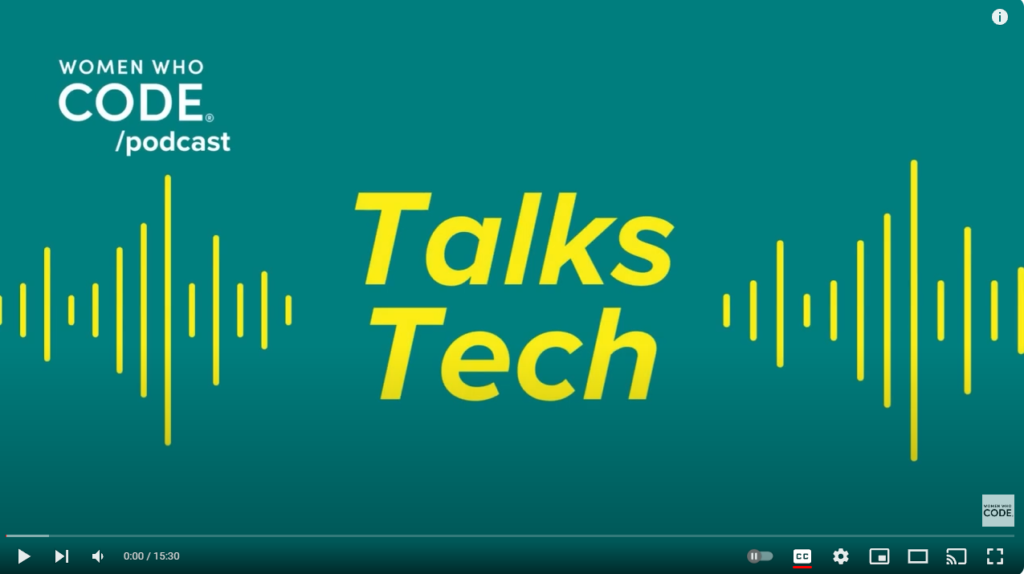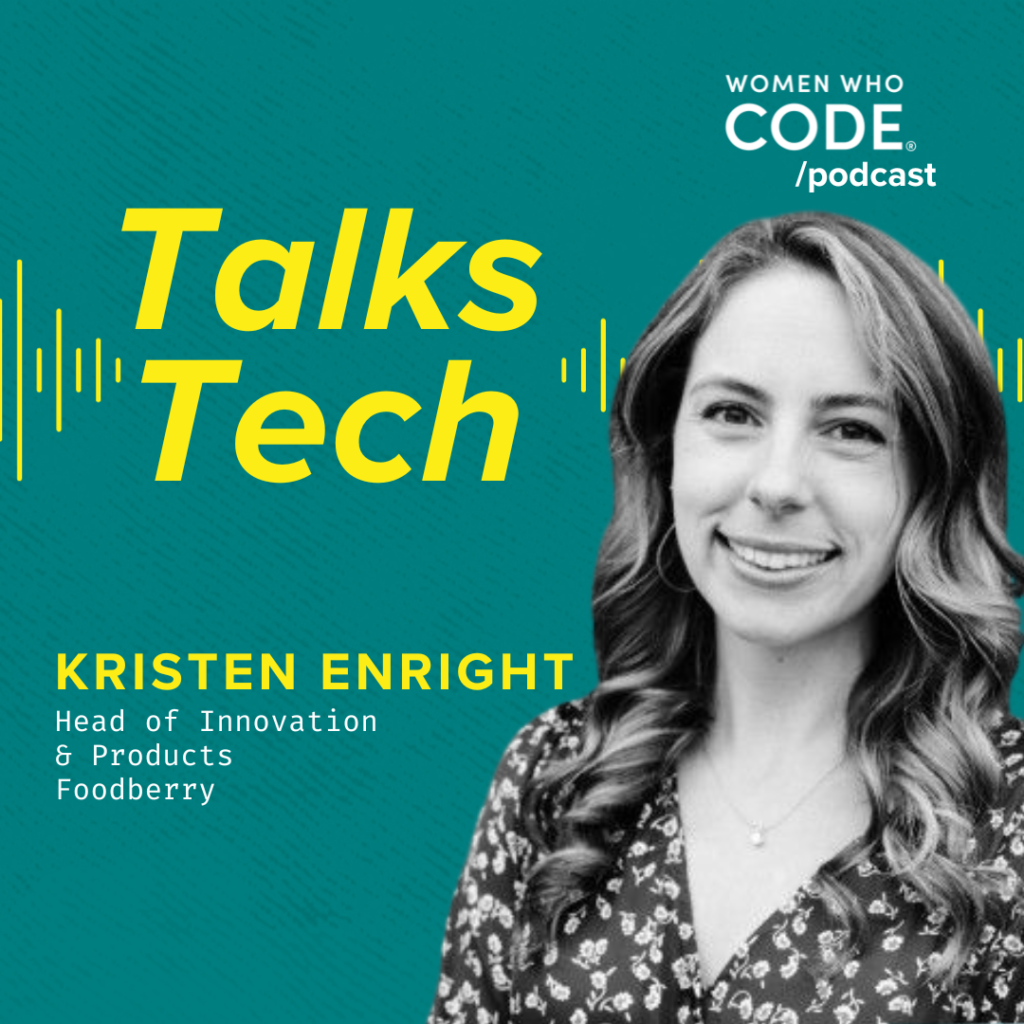Talks Tech #52: An Exciting Blend of Technology and Food
Written by Kristen Enright

iTunes – Spotify – Google – Video – More Episodes
Stephanie Rideout, Digital Community Specialist at Women Who Code, sits with Kristen Enright, Head of Innovation and Products at Foodberry. They discuss how a picture of cheese led Kristen into food technology, astronaut food, and other innovative snacks.
When did you first have an interest in food science, and why did you decide to study food science?
My love for food started at a very young age. I’ve always loved food. I love eating. I love cooking. I love researching restaurants and experimenting with recipes. Food has always been my happy place. Academically, I would say my background was in math and science. I loved everything that explained how things worked.
In high school, I had an incredible chemistry teacher who inspired me to pursue a degree in chemistry. I went to school for chemistry. I learned about food science later in my career. I studied biochemistry at Colby College in Maine and fell in love with applying chemistry to understand how the human body works. I started researching exercise and metabolism, which led to my first job at the Joslin Diabetes Center. There, I worked for Dr. Lori Goodyear in her lab to understand the metabolic pathways stimulated by exercise and how this could be used to help treat type 2 diabetes.
I was there for a few years and then took graduate classes at the University of Chicago for Biophysical Sciences. I was at a bit of a standstill trying to figure out what I wanted to do and not seeing a career path in research that exactly appealed to me. I decided to move back to Boston, where I found this job opening at a startup company in Cambridge. It was called WikiCell Designs, and I can still remember visiting the website for the first time and exactly what it looked like. There were these little pictures of cheese balls with colorful coating on them. It was so different from anything I had ever seen before.
I was so intrigued by it. My two favorite topics, food and science, came together. It just seemed like a dream job. That company was founded by a Harvard professor, David Edwards. They were based in Paris and were looking to open a new lab in Cambridge. That was 11 years ago, and I’ve been with the company ever since. I’ve seen it evolve. I myself have evolved a lot there, starting as a research associate, eventually running the R&D lab, and now leading as the head of innovation and products.
What was your experience at NASA, and how did that experience influence and establish the foundation for your career?
It was a great experience. Full disclosure: it was a summer internship when I was in college. It was one great summer there. It was an amazing program that they had set up for students to be able to come. It was at the Johnson Space Center in Houston, Texas. It’s where they do a lot of the training for astronauts. We got to see many of the different facilities they train in. My specific lab was cool. It was the nutritional biochemistry lab, and they were studying the effects of prolonged spaceflight on the different nutrition needs of astronauts.
One example is that you’re up in space without sunlight, so you don’t have any sun or UV to convert vitamin D to its active form. We had to adjust what astronauts were eating to compensate for the lack of sunlight. Another overall issue that is present when on the International Space Station is there’s not a lot of space for food or storage, especially for things like refrigerated and frozen foods.
Nutrient density is a really important part of the food in the astronaut’s diet. That is what carries over to a lot that we think about at Foodberry, nutrient density, and how we can create snack foods that are just full of good things and kind of make every bite worth it.
Tell us about your work at Foodberry as the head of innovation and products.
We’re a Boston-based food tech startup. We are developing ways to make hydrated, healthy foods more snackable by wrapping them in plant-based coatings made from fruit and vegetable fibers. As the head of innovation and products, my major role is helping to create new products for specific brands.
I do a lot with business development, talking to different partners, and figuring out what they want in products. It could be different requirements, such as the nutrients they want in the food. They want to hit certain nutrient claims with certain ingredient restrictions, which usually matches some concept they have developed with their marketing team. This is a proven concept that they know will be a winner with consumers, and they’re looking to find a product that helps match it.
We have a whole portfolio of products that we’ve made. They’re at various stages of commercialization. We can help match what people are looking for in a product, figure out what’s in our portfolio we can offer them, and create these customizable snacks. What they love about our products is that we’re creating new things. When we do consumer testing and launch new products, that’s what we hear over and over again: people are just so excited to try something new and different that also delivers on a health promise.
What excites you about the blend of technology and food?
Food technology has had a bit of a reputation for just being a dirty word. People don’t like to hear about technology and science in their food. It’s something that enables so much accessibility for food for people. Food technology started with preservation and making foods last longer so people can access them.
Over many decades, I think there was a bit of a standstill in food technology. More innovation was around, like a new flavor or a low-fat version. In the past ten years, we’ve seen so much growth in food technology. A lot is going on around plant-based meats and a lot of these alternative foods. It takes a lot of creativity and thinking outside the box. It’s using standard ingredients in new ways. It’s using manufacturing equipment in new ways. There’s a lot of potential for the future as we keep blooming this idea of food tech.
Where is the industry going, and what technological advances are you most excited about?
It’s opening up so many different options now. You go to food conferences, and you get to see how many different things are out there. There are alternative versions of foods. There is enhanced nutrition in food. I love the idea of personalized nutrition, things like looking at different probiotics and customizing your microbiome.
One way that Foodberry is starting to dip our toes into that is that we have the ability to deliver products that have both prebiotics and probiotics together in one piece. Usually, you can’t have these together because the probiotics will consume the prebiotics. We have our core and our coating together in one product. Once it’s in your gut, the two can work together and have their beneficial effects. What I love about Foodberry is the different ways we can apply our tech to these areas.
What advice would you like to give to diverse women technologists who are interested in pursuing tech leadership roles?
Learn from all the women that you meet along the way. Listen to their stories and learn from their successes. Think of everybody that you meet as a possible mentor and stay connected to them throughout your career. This is the network that will build you. I love phrase imitation, which is the highest form of flattery. If there’s something that you admire about someone, then try to incorporate that in your style and grow into the person that you want to be. I’ve had my high school chemistry teacher, my first PI at Joslin, a former CEO at Foodberry, and many great women who have influenced my journey. Even though our paths have been so different, they’re all people that I still think about and admire and try to build my career off of.
What is a pro tip you would like to share?
I have a pro tip around packing kid’s snacks, and this comes from my day-to-day at Foodberry, where we’re constantly trying to work on reducing the packaging of snacks. One fun thing is to try to reuse packaging. One of my favorite things is these little cups that you get hummus in; they’re two-ounce and single-serve hummus. You can use it once you clean those out for just about anything. You can use it for paints. You can use it to pack cut-up cheese. I probably have about 50 of them in my cabinets; they’re so reusable and wonderful. As we are always trying to think about reducing packaging in our products and how we can make life easier for parents, just trying to find ways to reuse things is fun, and the kids think it’s fun, too.

***************
Episode: https://www.womenwhocode.com/talks-tech-52-an-exciting-blend-of-technology-and-food
Video: https://youtu.be/goGY7o0B3kc
Guest: Kristen Enright, Head of Innovation and Products at Foodberry
LinkedIn: https://www.linkedin.com/in/kristenhitchcox/
Instagram: @foodberry_co
Host: Stephanie Rideout, Digital Community Specialist at Women Who Code
Producer: JL Lewitin, Senior Producer, Women Who Code